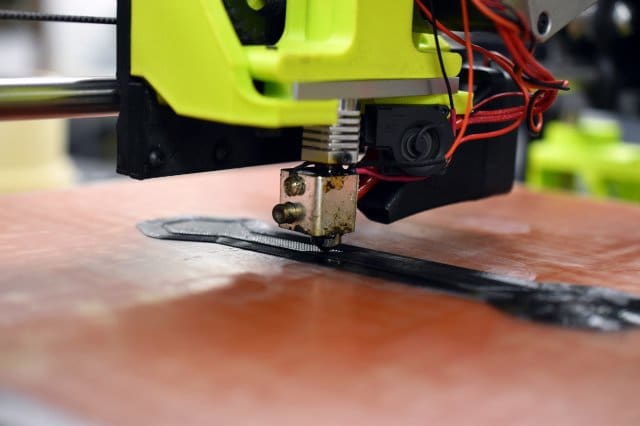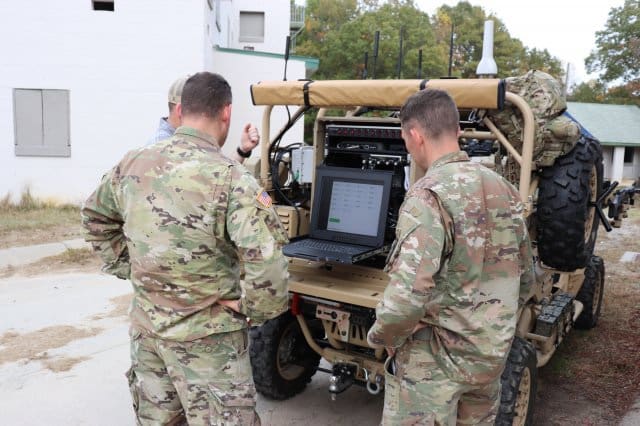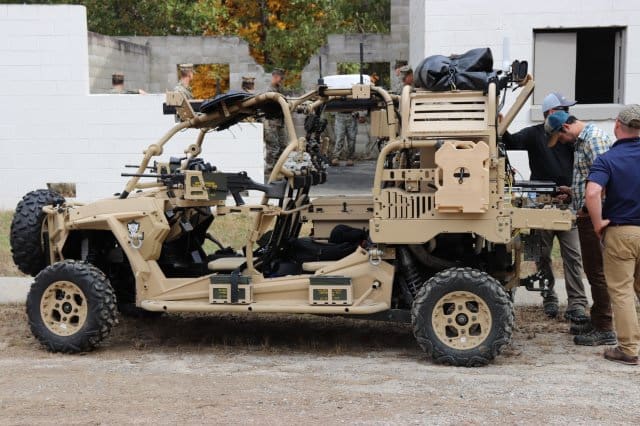ARLINGTON, Va. — The Army’s advanced manufacturing push intends to cut production timelines and costs throughout the lifecycle of systems, said an Army acquisition officer.
“Can you imagine how great it would be if we could just not have any parts in the logistics system, only raw materials, and we would just print the part at the point of need, right?” asked Maj. Gen. David Bassett, program executive officer for Command, Control, and Communications – Tactical, or C3T, during a panel discussion Wednesday.

That vision has become synonymous with advanced manufacturing, he said during the Association of the U.S. Army’s “Hot Topic” forum on Acquisition and Contracting.
Advanced manufacturing forges innovative technologies to “create new, or improved products or processes,” said Paul Mehney, C3T public communications director.
One technique, additive manufacturing, incorporates 3D printing, robotics, artificial intelligence and composite materials. But according to Bassett, that’s just a fraction of what the new push entails.
Over the last several months, C3T project managers have partnered up with the members of the Army’s Command, Control, Computers, Communications, Cyber, Intelligence, Surveillance and Reconnaissance Center — known as the C5ISR — at Aberdeen Proving Ground in Maryland and applied 3D printing techniques for network integration efforts.
At the proving ground, they have been prototyping radio, gateway and server racks, and mounting brackets on lightweight military vehicles to support network enhancement efforts of the Integrated Visual Augmentation System.
“The use of 3D printing enables developers to experiment with form/fit/function of different mounting systems and also allows developers and integrators to quickly incorporate Soldier feedback,” Mehney said.

To enable network connectivity for the Integrated Visual Augmentation System, developers are prototyping an integrated network enhancement kit called the Bloodhound, Mehney said.
Bloodhound is a network communications gateway and data management kit currently integrated onto light vehicles — but it is platform agnostic, he said, meaning it runs equally well on more than one platform.
During recent IVAS Soldier Touchpoint experimentation, infantry Soldiers and Marines provided feedback on the location of network systems on the Bloodhound, and made suggestions to improve form and fit of integrated network components.
“Future IVAS network capabilities may include data synchronization over narrow band SATCOM [Satellite Communications] with up to 75% reduction in component payload size, which will allow for network kit integration into combat and tactical vehicle platforms,” Mehney said.
IVAS network capability integration on the Stryker and Bradley platforms are both already in motion.
“3D manufacturing techniques will allow additional prototypes to be made as more Soldier feedback in development and operations is received, and as additional vehicle platforms are identified for network kit integration,” Mehney said.
Last month, the U.S. Army Combat Capabilities Development Command Soldier Center, in partnership with the University of Maine, procured the world’s largest 3D printer, to further bolster collaboration with industry leaders.

The printer will enable the rapid creation of large products for the Soldier, said Professor Habib Joseph Dagher, Advanced Structures and Composites Center executive director at the college.
Once a design configuration is locked, design plans developed out of advanced manufacturing techniques will be handed to industry for production.
Although the Army fostering of advanced manufacturing methods and materials are in its early stages, the service’s industrial base “must rapidly innovate to keep pace with industry and adversaries exploiting” their own advanced methods and materials, according to an Army statement.
But digital engineering is only the start, Bassett said. “Techniques [with advanced manufacturing] are now available to us that should aid in efficiency, and allow us to build things we never could have envisioned.”
In other words, 3D printing is only a part of advanced manufacturing and it “looks across the entire lifecycle of the system, starting with design, manufacturing and sustainment,” Bassett said.
“If you start to build a system this way,” he said, “when you get to sustainment, you should be able to identify what parts you can manufacture in different ways.”
The Army’s new manufacturing policy is made up of three elements: strategic investment, systematic adoption, and deliberate and thoughtful use, said Brian Raftery, acting deputy assistant secretary of the Army for strategy and acquisition.
Strategic investment must “develop a holistic, threat-based strategy for the investment in and use of advanced methods and materials” and open the door for outside partnership with industry leaders, he added.
The second principle integrates advanced manufacturing technology upfront, and throughout the system’s lifecycle, Raftery said.
And lastly, advanced manufacturing will be deliberate and used thoughtfully, he said. This means it will keep in mind aspects of things like return on investment and intellectual property implications.
Story by Thomas Brading
First photo by SSG Armando R. Limon


While it is an unique solution to one off parts… and proof of concept, the printed parts come at a MUCH higher cost (than an injection molded part) by more than 1000 times! The system to produce the parts (3D printers) are rather fragile in nature and do not like raring atmospheric conditions.
Norwegian FFI have been exploring 3D printing for quite a while and it’s been very successful- to the point where it spawned a civie company (FieldMade)to offer container based workshops.
Norway is doing some great stuff. In fact, there have been some high level discussions on how our countries can better collaborate on technology transfer.
I was trying to find an article I believe that I have read on the subject, but my brain isn’t working right at the moment.
FFI (Norwegian Defense Research Institute) and Fieldmade at least has some cooperation with the NATO AM community which I would expect the US to be a part of.
It’s for sure an exciting concept, AM is very cool, and when you move into stronger materials such as titanium or carbon fiber reinforced plastics then the durability of on-the-spot replacement parts with minimal logistics becomes a no-brainer.